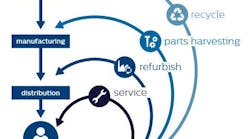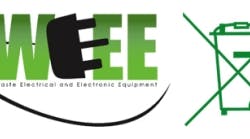Fagerhult teams with metals company for aluminum recycling
LED lighting vendors continue to ramp up their pursuit of environmental sustainability, tackling challenges including materials, transportation, packaging, manufacturing, and more. In the latest example, Sweden’s Fagerhult has piloted a process that it says improves aluminum recycling.
The Habo-based company is working with Hydro Extrusion Sweden AB, providing the aluminum company with discarded aluminum luminaires that Hydro is melting and reshaping into a fully sturdy state.
Aluminum in general is a highly recycled material. But sometimes recycling can undermine its quality.
“Many of our luminaires have an aluminium body, and we want to ensure that they can be optimally recycled without losing the quality or properties of the material,” said Niclas Thulin, head of sustainability at Fagerhult. “In collaboration with Hydro Extrusion Sweden, we are now exploring how we can close the loop.”
Although the lighting industry in general is heading toward a “reuse” model in which luminaires are refurbished and updated, reuse is not always possible, especially on older luminaires not designed with that in mind.
That was the case at the Snarøyveien 30 office complex in Fornebu, Norway, near Oslo, which houses Norwegian telecommunication company Telenor and other tenants. Real estate owner Norwegian Property has been remodeling the sprawling 200,000 square-meter (2.15 million square-foot) facility, and in the process Fagerhult reclaimed a large number of its aluminum Notor luminaires, which it handed over to Vetland, Sweden-based Hydro in what the two companies described as a pilot project. (LEDs Magazine has asked Fagerhult to quantify the impact.)
The luminaires were originally shaped with an extrusion process, which yields stronger aluminum than does die casting, an alternative process.
“When extruded aluminium luminaires are recycled, it is common for the material’s properties to undergo downgrading, and then be used in die casting, for example,” Thulin said. “In this project, we wanted to […] ensure the qualities of the material by allowing the original producer to process the material again.
“The pilot project resulted in the aluminium being melted down and reshaped,” Thulin continued. “Throughout the pilot project, the focus has been on circular processes and sustainable innovations. The goal has been to take new steps beyond the norm and the expected — and to overcome the major challenge of recycling used extruded aluminium — while preserving material properties.”
Hydro Extrusion account manager Kristian Frisk said that the reclaimed Fagerhult luminaires has provided 1,300 kilograms (1.43 U.S. tons) of aluminum for recycling.
“But the big gain is the insights we will take to future projects,” Frisk said, noting that, “Aluminium is a uniquely durable metal that can be recycled almost endlessly, but like all materials, it needs to be handled responsibly.”
This is not the first time that aluminum has made news in LED lighting sustainability circles. Early last year, Norwegian vendor Glamox announced it is using recycled aluminum in some of its luminaires.
And whether aluminum or not, vendors are moving toward more eco-friendly materials and processes, such as Signify’s push into 3D printed luminaires, and Fagerhult’s Italian brand, iGuzzini, using linen.
Follow our LinkedIn page for our latest news updates, contributed articles, and commentary, and our Facebook page for events announcements and more. You can also find us on the X platform.

Mark Halper | Contributing Editor, LEDs Magazine, and Business/Energy/Technology Journalist
Mark Halper is a freelance business, technology, and science journalist who covers everything from media moguls to subatomic particles. Halper has written from locations around the world for TIME Magazine, Fortune, Forbes, the New York Times, the Financial Times, the Guardian, CBS, Wired, and many others. A US citizen living in Britain, he cut his journalism teeth cutting and pasting copy for an English-language daily newspaper in Mexico City. Halper has a BA in history from Cornell University.









![The DesignLights Consortium continues to make progress in shifting outdoor lighting products and implementation practices toward a more restrained and thoughtful strategy. [Image does not represent a DLC qualified fixture.] The DesignLights Consortium continues to make progress in shifting outdoor lighting products and implementation practices toward a more restrained and thoughtful strategy. [Image does not represent a DLC qualified fixture.]](https://img.ledsmagazine.com/files/base/ebm/leds/image/2024/08/66be810888ae93f656446f61-dreamstime_m_265700653.png?auto=format,compress&fit=&q=45&h=139&height=139&w=250&width=250)